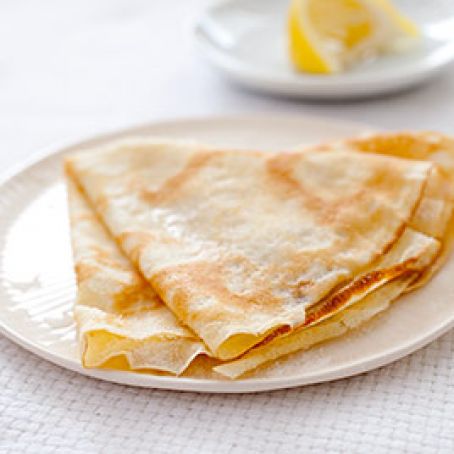Crepes with Sugar and Lemon
By AzWench
Crêpes will give off steam as they cook, but if at any point the skillet begins to smoke, remove it from the heat immediately and turn down the heat. Stacking the crêpes on a wire rack allows excess steam to escape so they won’t stick together. To allow for practice, the recipe yields 10 crêpes; only eight are needed for the filling.
 1 Picture
1 Picture
Ingredients
- 1/2 teaspoon vegetable oil
- 1 cup (5 ounces) unbleached all-purpose flour
- 1 teaspoon sugar, plus 8 teaspoons sugar for sprinkling
- 1/4 teaspoon table salt
- 1 1/2 cups whole milk
- 3 large eggs
- 2 tablespoons unsalted butter, melted and cooled
- 1 lemon, cut into wedges
Details
Preparation
Step 1
1. Place oil in 12-inch nonstick skillet and heat over low heat for at least 10 minutes.
2. While skillet is heating, whisk together flour, 1 teaspoon sugar, and salt in medium bowl. In separate bowl, whisk together milk and eggs. Add half of milk mixture to dry ingredients and whisk until smooth. Add butter and whisk until incorporated. Whisk in remaining milk mixture until smooth.
3. Using paper towel, wipe out skillet, leaving thin film of oil on bottom and sides. Increase heat to medium and let skillet heat for 1 minute. After 1 minute, test heat of skillet by placing 1 teaspoon batter in center and cook for 20 seconds. If mini crêpe is golden brown on bottom, skillet is properly heated; if it is too light or too dark, adjust heat accordingly and retest.
4. Pour 1/4 cup batter into far side of pan and tilt and shake gently until batter evenly covers bottom of pan. Cook crêpe without moving it until top surface is dry and crêpe starts to brown at edges, loosening crêpe from side of pan with rubber spatula, about 25 seconds. Gently slide spatula underneath edge of crêpe, grasp edge with fingertips, and flip crêpe. Cook until second side is lightly spotted, about 20 seconds. Transfer cooked crêpe to wire rack, inverting so spotted side is facing up. Return pan to heat and heat for 10 seconds before repeating with remaining batter. As crêpes are done, stack on wire rack.
5. Transfer stack of crêpes to large microwave-safe plate and invert second plate over crêpes. Microwave on high power until crêpes are warm, 30 to 45 seconds (45 to 60 seconds if crêpes have cooled completely). Remove top plate and wipe dry with paper towel. Sprinkle upper half of top crêpe with 1 teaspoon sugar. Fold unsugared bottom half over sugared half, then fold into quarters. Transfer sugared crêpe to second plate. Continue with remaining crêpes. Serve immediately, passing lemon wedges separately.
Technique: Whisk Away
Most recipes for traditional American pancakes caution against overmixing the batter; doing so activates the formation of gluten and will render the results tough and dense. In theory, the same logic would apply to crêpes, but our mixing tests showed that all that worry was for naught. Why? It all comes down to the liquid-to-flour ratio. The high proportion of liquid in crêpe batter makes it so dilute that gluten development—that is, the network of proteins that give baked goods their chew—is not actually a factor. This also means that you can use anything from low-protein cake flour to high-protein bread flour and get a similarly tender crêpe.
Technique: Is the Pan Ready?
Here's a test to make sure that the pan is hot enough: Drop a teaspoon of batter into its center. If this mini crêpe is golden brown on the bottom after 20 seconds, the pan is ready. If it's blond—or burned—adjust the heat accordingly.
Troubleshooting Crêpes:
PROBLEM: Splotchy browning
SOLUTION: Preheat pan 10 minutes
PROBLEM: Batter spreads unevenly
SOLUTION: Tilt and shake
PROBLEM: Crêpe tears when flipped
SOLUTION: Wait, then try again

Review this recipe